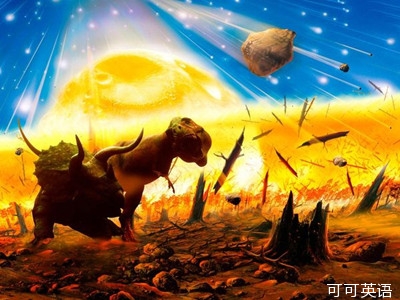Don: Time now for another episode of A Moment of Science's "Did You Know..." So, Yael, did you know that there have been about twenty-three mass extinctions since life began on earth?
唐:现在进入科学时刻另一段情节:“你知道...”那么,雅艾尔,你知道吗,地球上自有生命以来发生过23起物种大灭绝事件?
Yael: I know there've been a few extinctions, Don, but not that many!
雅艾尔:我知道几次物种大灭绝,但不知道次数如此多!

Don: Yep. Many were of prehistoric bacteria and other single-celled microorganisms. But in the past 540 million years or so there have been about five mass extinctions, mainly of marine plants and animals but also of land organisms.
唐:是啊。许多都是史前的细菌或其它单细胞微生物。但是在5.4亿年前已发生过5次大灭绝,主要包括海生植物和动物,当然也有陆生生物。
Yael: Well, I know that the dinosaurs disappeared about 65 million years ago, possibly due to a large meteor that crashed into earth and blotted out the sun. But what caused all those other extinctions?
雅艾尔:好吧,我知道恐龙大约在六千五百万年前消失,可能是由于一颗大流星撞击地球,遮住阳光引起的。但是什么导致其他物种灭绝的呢?
Don: That's been a mystery for a long time. But now some scientists think that most mass extinctions have been driven by the rise and fall of sea level. That may sound strange, but consider that millions of years ago a shallow sea covered the entire middle section of North America. That sea grew and shrank back several times. Each time it drained it caused entire species of sea plants and creatures to die off. The last time it drained was around 65 million years ago—when the dinosaurs disappeared.
唐:长期以来那一直是个谜。但如今一些科学家们认为大多数的灭绝是由于海平面的上升和下降引起的。这也许听起来很奇怪,但考虑到百万年前有一片浅海覆盖在整个北美洲中部就不足为奇了。那片海历经几次扩张和消失,每一次干涸就会导致这个海洋的生物灭绝。最后一次干涸发生在6500万年前恐龙消失的时候。
Yael: OK, I understand how a sea vanishing would kill off marine life. But did the sea's disappearance also have something to do with the dinosaurs going extinct?
雅艾尔:好吧,我明白了海洋的消失会引起海洋生物消失。但海洋的消失与恐龙的灭绝也有联系吗?
Don: Maybe. When a sea disappears it has a big effect on climate. All that water provides heat and moisture. And when a sea drains, the climate becomes drier and colder. So the change in climate may have combined with the meteor impact to kill off the dinosaurs.
唐:也许。海洋消失会对气候产生深远的影响。海水能提供热量和湿度。当海水干枯时,气候就会变得更加干燥和寒冷。因此气候变化再加上流星撞击地球足以将恐龙推向毁灭。












